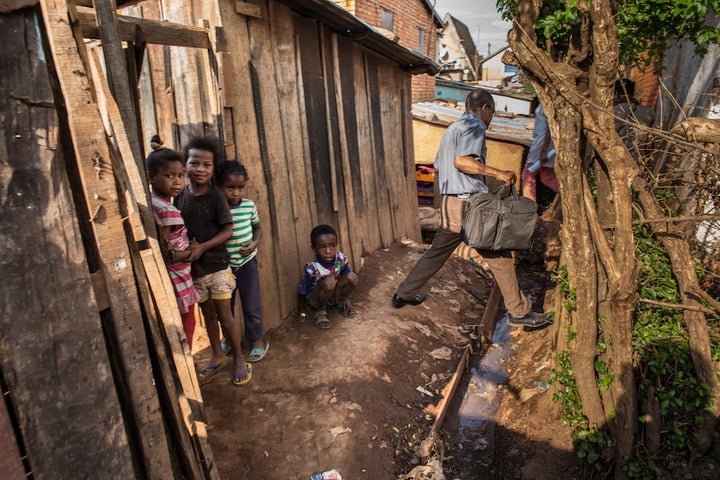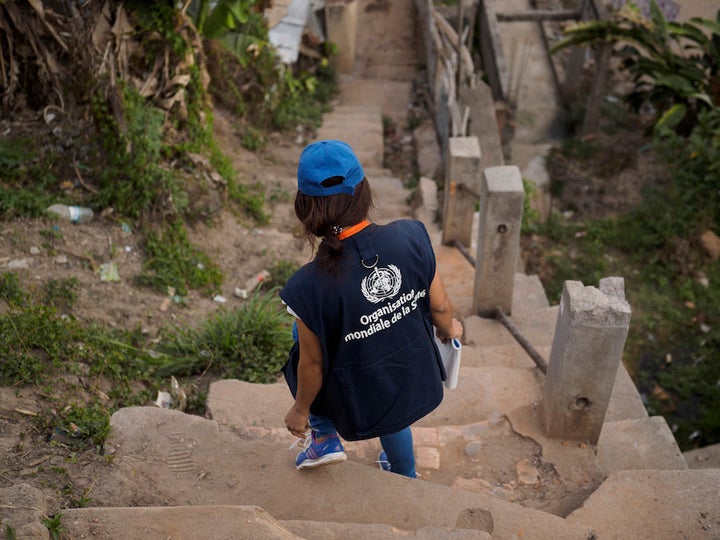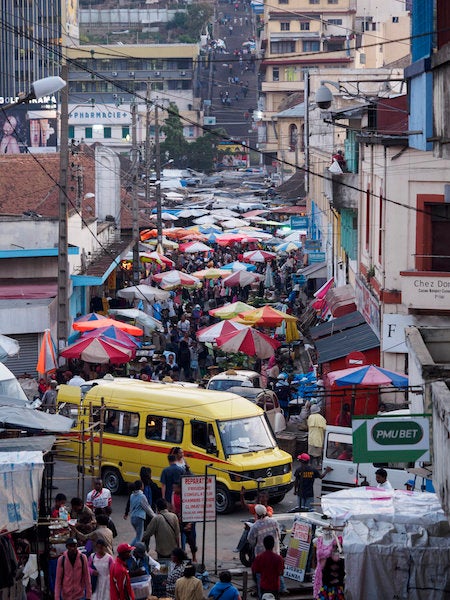This article is part of HuffPost’s Project Zero campaign, a yearlong series on neglected tropical diseases and efforts to fight them.
ANTANANARIVO, Madagascar ― This island nation is currently facing the world’s worst plague epidemic since the Vietnam War. Since August, the disease has infected over 1,000 people in Madagascar and killed more than 125.
Often the problem isn’t access to treatment. If caught in time, the plague can be treated with common antibiotics. But the shame surrounding the disease, which people associate with poverty and dirtiness, can prevent them from seeking care.

Andry, a thin, retiring young man of modest means who works as a night guard in the center of the capital, Antananarivo, said he could not believe it when his rapid diagnostic test turned up positive. “Positive? Positive for what?” he asked the doctor repeatedly. He had been coughing and feverish for two full days before his family convinced him to get tested.
Even in a normal year, Madagascar, located in the Indian Ocean, off the coast of southeast Africa, has more than half of the world’s total plague cases. Cynics here say stamping out the disease has never been a priority because, until now, it hasn’t affected the political class.
Bubonic plague, carried by rats and spread to humans through flea bites, is
commonly found in poor areas of the country’s central highlands. However, this
year, most plague cases are pneumonic, a more virulent form that is spread through coughing, sneezing or spitting. Andry, who asked that his real name not be used, believes he caught the disease while sharing cigarettes with his fellow guards.
Andry was likely treated just in time. Pneumonic plague is almost always fatal
within a few days if untreated. In some cases, people die in less than 24 hours. And though the disease is normally a rural problem, it is now mostly concentrated in urban areas, including the capital.
International agencies have reacted swiftly to this outbreak, pouring in millions of dollars. The World Health Organization teamed up with Madagascar’s health ministry to train medical professionals and health workers. In addition to promoting public information campaigns and pop-up treatment centers, they are trying to find anyone who’s come into contact with a person with the plague — “contact tracing,” in the jargon of epidemiologists.
The trouble is, many Malagasy people are embarrassed to be associated with the plague and do not want to be traced.
“The middle class believes this is not a disease for them — it’s for poor people in the low quarters,” said Dr. Fortunat Razafindralambo, the head of a public clinic in Antananarivo.

As the airborne pneumonic plague has spread, impervious to class distinctions,
medical officials have faced social challenges as much as biomedical ones.
The disease is seen as a sign of poverty, and above all, dirtiness. Some survivors and family members dread visits from health workers, whose presence marks their home as a plague site.
“When they see health workers at someone’s house, the neighbors say, ‘Oh, there is the plague!’” said Mamy Ramparany, a WHO manager in Madagascar, turning his torso and pretending to run, to demonstrate the general attitude.
After Andry was diagnosed on Oct. 13, health workers began checking in on his family twice a day. These visits were not entirely welcome. When he came home, after six days at the hospital, his uncle, a muscular man in stylish athletic gear who spoke English well, stopped a group of incoming health workers outside the house, and told them that he “hated their approach” — literally, he hated when they approached.
He was annoyed by the visits, which tipped off the neighbors to the situation. Both men found the plague “humiliating,” and agreed they would not
tell anyone about it.

On a mid-October visit to Antanetibe, a village just outside Antananarivo, a different team of health workers was similarly rebuffed. A young woman insisted her father had died of diabetes and she didn’t need to be checked on. A WHO supervisor patiently explained that this was just a check-up, not an investigation, but she still seemed eager for everyone to leave. She guarded the front door while a boy played on a desktop computer behind her. Eventually, she walked back inside without saying goodbye.
Despite the challenges, the effort to track down plague contacts continues, and the number of cases reported has been declining since mid-October. On a given day, more than a thousand Malagasy people are being monitored. Supervisors from the WHO and the health ministry are already working long hours, and cannot come on most visits. Community health agents, who are essentially unpaid volunteers, do most of the leg work.
Volatiana Raharimananjarahoby, a health agent in the Faliarivo neighborhood, in
the center of the capital, said she doesn’t worry about catching the plague.
“It’s risky, but I’m not afraid because I rely on God,” she said. The tough part of her job, she explained, is not avoiding the plague, but dealing with bashful victims and their families. Some won’t admit they’ve had the plague, and others won’t even let her in the door.

But in late October, she got a friendly reception from Princia, whose 14-year-old
daughter Monique came down with the pneumonic plague a week earlier. Monique had tested positive after suddenly developing a strong fever; she may have been infected at church. (Public gatherings are banned in Antananarivo, due to the plague outbreak, but most people still go to church.)
Monique received antibiotic treatment, which takes effect quickly. Within about
three days of her diagnosis, she had no signs of the disease. But she was being kept in the city’s main “anti-plague” hospital for a few more days.
As Raharimananjarahoby, the community health agent, went through her checklist to see if anyone else in the family had plague symptoms, Princia sat flanked by her two sons, Monique’s younger brothers. The room was full of furnishings and appliances that many Malagasy people don’t have: a dark hardwood dining-room table, a tall fridge, a flat-screen TV.
Yet unlike some other members of the middle class, Princia wasn’t embarrassed that her daughter had suffered from “a disease of poverty,” as the WHO called the plague in a recent statement. She simply asked when normal life could resume and when her boys could go back to school. She didn’t want them to endanger their classmates, she said. (Despite saying that they weren’t embarrassed, the family asked that their real names not be used.)
Poverty and poor governance have hurt efforts to fight the plague. Madagascar is listed among the United Nation’s Least Developed Countries; more than 90 percent of the population lives on less than $2 a day. Government programs to control the disease have been “hampered by operational and management difficulties,” according to a report by the European Centre for Disease Prevention and Control.
Unsafe burial practices that involve touching corpses are one reason the disease spreads. Families here bury their dead in the same tomb for many generations, and, in large turning-of-the-bones celebrations called famadihana, they remove buried ancestors from the tomb and wrap them in new silk shrouds.
“If someone is not buried in the family tomb, it’s like that relative has been lost,” said Dr. Hanitra Radavidrason, medical coordinator of the Malagasy Red Cross.
The plague first arrived in Madagascar in 1898, when steamships from India
brought rats infected with the Yersinia pestis bacteria that causes the disease. It
nearly disappeared from Madagascar for 60 years, beginning in 1930, but has re-emerged in the past three decades. The black rats that carry the disease in Madagascar’s highlands have gradually developed resistance to it.
Malagasy people have not developed resistance to the plague, nor to the insidious notion that it’s a shameful disease caused by being dirty — that it’s somehow the victim’s fault. Until this stigma is addressed, the plague will remain a modern problem, one that doctors and epidemiologists can’t solve alone.

This series is supported, in part, by funding from the Bill & Melinda Gates Foundation. All content is editorially independent, with no influence or input from the foundation. If you’d like to contribute a post to the series, send an email to ProjectZero@huffingtonpost.com.